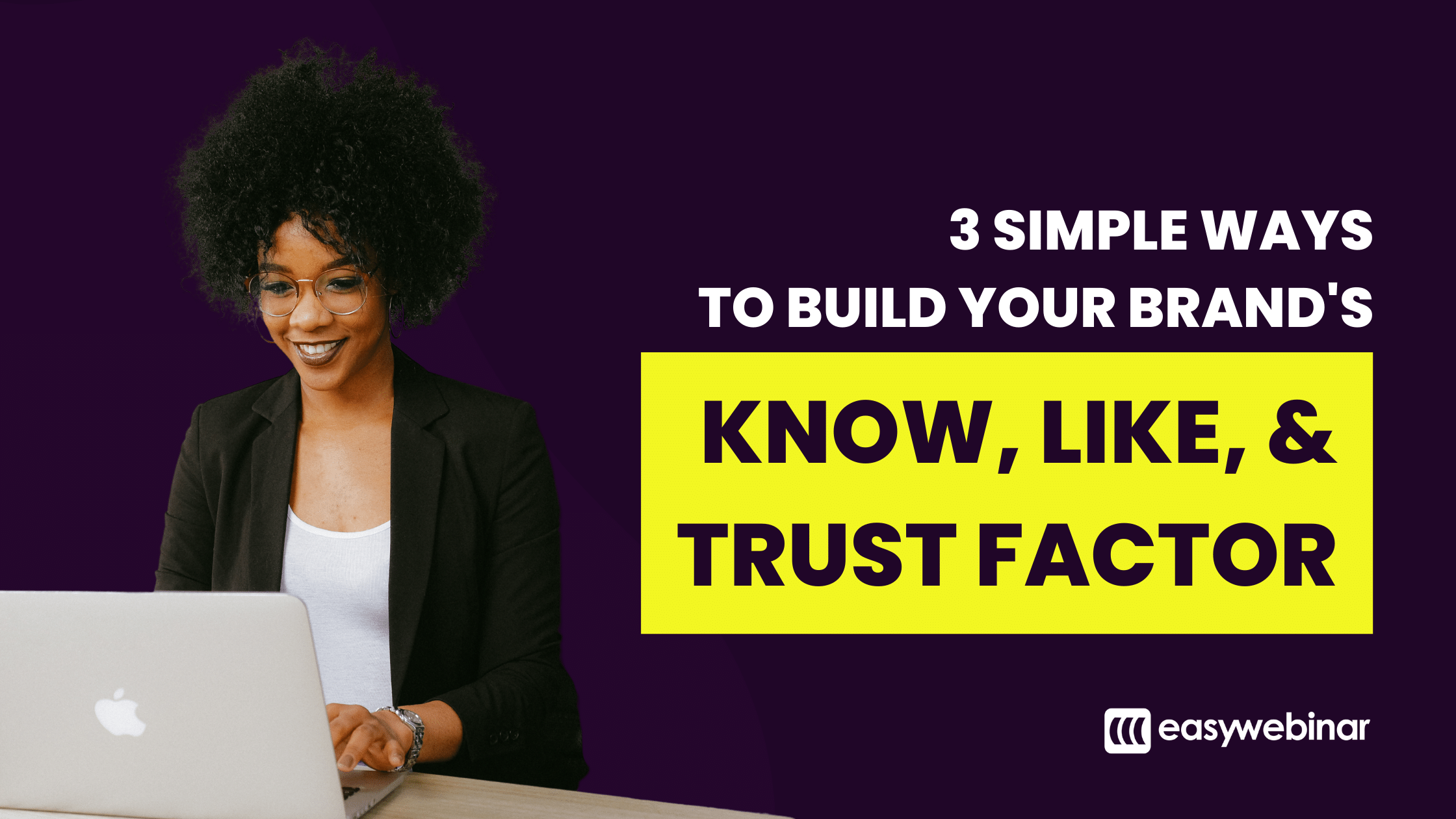3 Simple Ways to Build Your Brand’s “Know, Like, and Trust” Factor

Table of Contents
- The Golden Age of Online Creators: Mastering the “Know, Like, and Trust” Factor to Build Your Brand in 2025
- Know, Like, and Trust (KLT): What It Really Means in 2025
- 3 Ways to Build Your Brand’s Know, Like, and Trust Factor
- Quick Win: Use Webinars to Jump-Start Your KLT Factor
- Conclusion
- FAQs
The Golden Age of Online Creators: Mastering the “Know, Like, and Trust” Factor to Build Your Brand in 2025
We’re in the midst of multiple Golden Ages. From the Golden Age of Streaming to the Golden Age of Athleisure, one thing is clear: online creators are thriving. In 2025, it’s safe to say we’re deep into the Platinum Age of Online Course Creators.
With shifts in consumer behavior and rising expectations around authenticity and brand values, it’s no longer just about being seen. It’s about being trusted.According to the 2024 Gustavson Brand Trust Index, trust in a brand name is still primarily driven by authenticity, purpose, and alignment with consumer values. In today’s economy, brand awareness is not enough—trust is now the most valuable currency.

Know, Like, and Trust (KLT): What It Really Means in 2025
The Know, Like, and Trust Factor (KLT) is a foundational concept in brand and marketing strategy. It describes the psychological journey your audience takes before becoming loyal customers—or, ideally, raving fans.
In the age of micro-influence and digital intimacy, developing this connection is your greatest branding asset.
A high KLT Factor means:
- People know who you are
- They like how you communicate
- They trust your values and company logotype enough to invest in your products or services
You don’t need millions of followers. You just need the right ones.
Kevin Kelly’s “1000 True Fans” theory—updated in 2023—emphasized that just 1,000 people spending $100 a year can support a six-figure business. Today, automation, community platforms, and webinars make cultivating those fans even easier.
“In 2025, it has never been easier to develop a brand and build loyal audiences around it,” — MarketingProfs 2025 Trend Report

The Know, Like, and Trust Factor (KLT) has evolved from a marketing framework into a strategic foundation for digital brands. In a time where consumers are constantly bombarded with choices, KLT has become the filter through which every decision is made. It’s not enough to be seen—you have to be felt.
In 2025, brand loyalty is deeply emotional. Buyers don’t just want great products—they want to align with creators and companies whose mission and values reflect their own. That’s why building relational equity is more powerful than building visibility alone. When your audience knows your story, likes your presence, and trusts your intentions, you don’t compete on price or algorithm—you stand on connection.
Your company logotype, voice, tone, and even your design choices serve as trust signals. They’re visual shortcuts for what you stand for, how consistent you are, and how dependable your brand is. This psychological safety triggers one of the most powerful conversions of all: belief.
In today’s community-driven digital economy, micro-fandoms hold more weight than mass followings. The rise of private communities, paid newsletters, and niche creator platforms shows that people aren’t just following creators—they’re choosing to build with them. And creators who use their platforms to educate, share transparently, and lead with empathy are the ones who turn casual scrollers into lifetime customers.
Additionally, behavioral data from 2025 digital consumer reports shows that:
- Brands with clear messaging and values see 47% higher retention.
- Trust-based brands convert 60% faster than ad-reliant competitors.
- Personalized, story-driven content outperforms generic content by over 3X in engagement.
So while flashy growth hacks may come and go, the creators and companies who invest in the slow burn of KLT-based brand development are building something more powerful: community, credibility, and conversion that lasts.
Now is the time to develop a brand that puts relationships first. When you center your business around the human experience—not just the transaction—you’ll build not only revenue, but resonance.
3 Ways to Build Your Brand’s Know, Like, and Trust Factor
Number One: Get Visible
If you want people to know you, you need to show up—as yourself. Whether through Reels, YouTube, blogs, or your email list, consistency is key.
Take Alex Cattoni, founder of Copy Posse. In 2025, her YouTube channel continues to be a powerhouse. With over 300,000 subscribers, she attributes her success to one truth: “People can’t know, like, and trust you if they don’t know you exist.”
Freelancer and course creator Alexandra Fasulo echoes this. She once delayed sharing her entrepreneurial journey out of fear—and now encourages others to “do it afraid.”
Visibility builds brand awareness—but authentic visibility builds trust.
Tip:
- Choose one platform to start.
- Use your company logotype consistently.
- Don’t aim for perfection. Aim for truth.

Alexandra Fasulo, a successful freelance writer turned multi-passionate business owner and course creator, spoke of this fear on her podcast Freelance Fairytales. In her episode about the fear of putting oneself out there as a freelancer, she said that “one of the biggest mistakes of her professional life” was not posting about her freelance journey on social media for four years. She “couldn’t bring herself to do it” and held back on posting her “intent and commitment to being a savvy businesswoman,” because she was “afraid of what people might think or say.”
She now encourages freelancers and business owners to share their work and talents publicly…and she’s quite successful at it! By sharing her experiences candidly, Alexandra’s KLT Factor is sky-high.
Another example is seven-figure copywriter and course creator Alex Catonni, who shared about the fears she had starting her YouTube channel. She actually described herself as being “terrified.” She didn’t want to fail publicly. (Can you relate?)
Two years and over 180,000 subscribers later, she attributes YouTube to being one of the greatest growth factors in her business. She summed it up so well: “People can’t know, like, and trust you if they don’t know you.”

Number Two: Tap Into Your Brand’s Values
In 2025, we are living in a purpose-driven economy. According to a HubSpot Brand Trust Survey (2024), 78% of consumers say they would switch to a brand that aligns with their values—even if it means paying more.
Your audience wants to know:
- What you believe in
- Why you’re doing what you do
- What sets you apart from other brand and marketing messages
If you want to develop a brand that resonates, begin with these questions:
- What’s your brand’s mission?
- What do you value most?
- What causes or communities do you support?
- How do your values show up in your content, customer service, or products?
Real-World Example:
Reformation Clothing continues to include sustainability updates in their quarterly newsletters. It’s not just a one-day campaign on Earth Day. It’s built into their DNA—and consumers notice.

Number Three: Share Consistently
Building trust isn’t a one-time event. It’s a continuous, intentional effort. The brands that stand out in 2025 are those that don’t just post when it’s trendy—they share consistently across touchpoints.
Use:
- Email newsletters
- Blog posts
- Podcasts
- Webinars
- YouTube or TikTok (whichever suits your audience)
Consistency builds credibility. People start to expect your presence, your perspective, and your values. And eventually, they begin to feel like they know you.
A Strong Example:
Hannah Bronfman’s “Hannah’s List” remains a trusted bi-weekly newsletter in 2025, where she continues sharing fertility awareness stories and wellness content with transparency. Her willingness to be vulnerable has led to massive KLT growth.

Quick Win: Use Webinars to Jump-Start Your KLT Factor
Webinars are one of the fastest ways to accelerate your Know, Like, and Trust journey. Hosting no-pitch, value-first webinars lets your audience:
- Learn from you in real time
- Experience your style
- Join your email list
- Ask questions and build rapport
In fact, platforms like EasyWebinar saw a 33% increase in creator sign-ups in 2025, proving the format remains a top-performing engagement tool.
Final Thoughts: Building a Brand That’s Built to Last
To brand better in 2025, it’s no longer enough to just show up on social media with polished graphics and a clever tagline.
You must:
- Be visible, even when it’s uncomfortable
- Align your content with your values
- Share with consistent honesty
- Commit to building community over chasing vanity metrics
The KLT Factor isn’t just a strategy—it’s your long-term brand moat in a world where trust is the most precious commodity.

Conclusion
In 2025, success is no longer measured by how many followers you have or how slick your branding looks. It’s about connection over clicks, and trust over traffic.
The Know, Like, and Trust Factor (KLT) is not just a trendy marketing buzzword—it’s the core of building a brand better in a saturated online market. With endless options, your audience is craving authenticity, purpose, and real value.
Whether you’re just starting to develop a brand, or scaling your existing business, the KLT Factor empowers you to:
- Stand out by being real, not perfect
- Build emotional loyalty through shared values
- Convert leads into customers—and customers into ambassadors
The best part? You don’t need a massive ad budget or a celebrity following. You just need a consistent message, a visible presence, and a willingness to share the why behind your brand name.
As consumers move further away from faceless corporations and closer to human-centered brands, creators who prioritize brand and marketing through KLT will lead the future.
FAQs
1. What is the KLT Factor and why does it matter?
The Know, Like, and Trust Factor is a marketing principle stating that people only buy from brands they feel connected to. In 2025, where trust drives purchasing decisions, KLT is essential for growing any brand online.
2. How can I improve my KLT Factor as a beginner creator?
Start with one content platform (like YouTube, Instagram, or a newsletter), share personal stories or brand values, use your company logotype consistently, and engage with your audience regularly.
3. Do I need a big audience to see results from KLT marketing?
No. With concepts like 1000 True Fans, you can build a sustainable six-figure business with a small but highly engaged audience that knows, likes, and trusts you.
4. How does my brand’s visual identity affect KLT?
A strong, recognizable brand name and company logotype support the “Know” stage by building familiarity. Visual consistency across your website, emails, and social media boosts credibility and trust.
5. How often should I post or show up to build trust?
Consistency matters more than frequency. Whether it’s once a week or three times a week, keep showing up with authentic, value-driven content that aligns with your brand and marketing goals.
